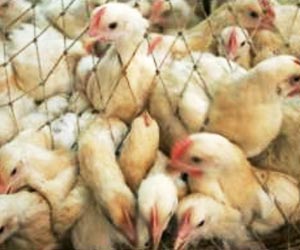A probe into an outbreak of bird flu at a Hong Kong chicken farm and carcasses popping up in city waters have raised questions over whether the H5N1 virus is going undetected in southern China.
A probe into an outbreak of bird flu at a Hong Kong chicken farm and carcasses popping up in city waters have raised questions over whether the H5N1 virus is going undetected in southern China.
The report released this month said wild birds were the most likely carriers of the virus that broke out in December on a farm close to the territory's border with the southern Chinese province of Guangdong, prompting the culling of 90,000 chickens.While the authors could not say for certain where in Asia the wild bird may have contracted H5N1, the report said the specific version of the virus was the same as that "currently circulating among poultry in southern China".
The report came days after two dead chickens with H5N1 were found floating in the sea off Hong Kong, the latest of more than a dozen chickens, ducks and other birds to wash up along the city's coastline since the start of year.
"From the various investigations we have done (the washed-up carcasses) are most likely drifting down from the Pearl River," Hong Kong's health secretary York Chow said in early February.
Hong Kong sits at the southern tip of a Guangdong's large Pearl River delta.
Malik Peiris, a virologist at Hong Kong University and one of the world's leading bird flu researchers, said he agreed with Chow's assessment.
Advertisement
While Hong Kong has publicly confirmed 15 bird flu cases this year in addition to the December outbreak on the poultry farm, Guangdong has posted no bird flu findings since June 2008.
Advertisement
Peter Cordingley, the Asia-Pacific spokesman for the World Health Organisation, said the appearance of the dead birds was an issue of concern.
"From a public health point of view we are concerned about South China," he said, adding that Hong Kong's surveillance systems for outbreaks in humans and poultry was the "international gold standard".
A spokesman for China's health ministry declined to comment.
In early February, a grey heron was found dead in boggy water at the Mai Po nature reserve within sight of the border.
The heron tested positive for H5N1, the first at the reserve since testing began in 2003, shifting the focus onto the role of wild birds in the spread of the disease.
This was reinforced by the poultry outbreak investigation that found wild birds the "most likely" carrier.
But most experts believe wild birds cannot explain the prevalence of the disease in the region.
"The wild birds are more like canaries in a coal mine (for infected poultry)," said Martin Williams, a bird expert and environmental activist.
Peiris said that although the role of wild birds in the spread of the virus needed to be studied, intensive farming should be the main focus.
"Poultry production and the movement of poultry are probably far more important as the route of the maintenance and dissemination of these viruses," said Peiris.
Scientists are concerned that poultry farms act as an ideal breeding ground for the virus to mutate as so many carriers are in close proximity.
H5N1 has killed more than 250 people worldwide since 2003 -- and also led to the culling of millions of chickens -- but scientists' deepest fear is that a pandemic killing millions could be triggered if the virus mutated to become easily transferable between humans.
And so any outbreak must be reported quickly.
"Controlling the poultry outbreak, I would say, is the most important element in the overall control of H5N1," said Lo.
While no H5N1 reports have come out of Guangdong this year, eight people elsewhere in the mainland are known to have caught the virus, and five of them have died.
Seven of the eight had known close contact with poultry, but despite extensive testing -- praised by the Food and Agriculture Organisation -- only one poultry outbreak has been found, in the northwestern province of Xinjiang.
"Human cases have become increasingly difficult not to report," Lo said.
However "we always ask the question, when human cases are reported, where is the source of the infection?"
Source-AFP
SRM









